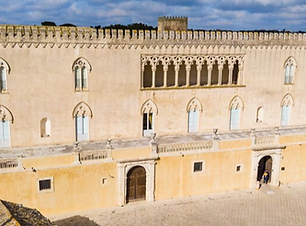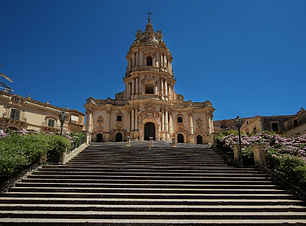
Surroundings
The villa is located in south-eastern Sicily, in the "baroque" heart of the Val di Noto, (UNESCO Heritage).
Thanks to the strategic position, you can visit all the tourist sites in the area.
It is possible to easily reach Ragusa Ibla, Scicli, Modica, Noto and all the places of "Inspector Montalbano" (famous protagonist of the television series based on the novels by Andrea Camilleri).

Ragusa Ibla
Ragusa Ibla, the magnificence of a town that seems to have been carved directly into the rock. Today considered the historical part of the city of Ragusa. If you are wondering what to see or why it is worth visiting, a number will suffice: 18. There are many monuments recognized by UNESCO as a World Heritage Site.
After the catastrophic earthquake of 1693, Ragusa was rebuilt on two different sites: the upper part, considered modern, and the lower part, which was redesigned in Baroque style, on ancient ruins.

Marina di Ragusa
The beach of Marina di Ragusa is among the busiest seaside resorts in Sicily. The coast is made up of a series of long, narrow beaches of fine golden sand and shallow seabed. In recent years the town has been considerably enriched with chalets, restaurants, pubs and various recreational venues, thanks to constant increases in tourism, today it is a well-known tourist destination that welcomes tens of thousands of tourists and holidaymakers, especially during the summer period, but is also a destination for people who come to spend the winter during the winter period, all thanks to the excellent climate, the clear sea and the beautiful beaches .

Noto
Noto is located on the south-eastern coast of Sicily, in the province of Syracuse. Together with the other territories of the Val di Noto, its historic center has been declared a UNESCO heritage site since 2002. After the earthquake of 1693 the city was completely rebuilt in Baroque style, becoming a symbol par excellence in the world

Donnafugata Castle
The Donnafugata castle is located in the municipality of Ragusa , about 15 kilometers from the city. Sumptuous noble residence from the late 19th century overlooked what were the possessions of the rich Arezzo De Spuches family. There are various hypotheses on the origin of the name "Donnafugata". It is usually traced back to a legendary episode, such as the escape of Queen Blanche of Navarre , widow of King Martin I the Younger and regent of the kingdom of Sicily who was imprisoned in the castle by Count Bernardo Cabrera ,

Modica
Modica, a hidden gem in the heart of Sicily, is a city rich in history, culture and natural beauty. until the 19th century it was the capital of a county that exerted vast political, economic and cultural influence. Its historic centre, rebuilt following the devastating earthquake of 1693 , constitutes one of the most significant examples of late Baroque architecture .

Cava Gonfalone
Cava Gonfalone is an exceptional site of industrial archaeology. For over 200 years the "pirriaturi" (stone quarryers) have extracted blocks of stone useful for building Ragusa. The result is an evocative space that extends for 15,000 square meters under the city, a sort of negative city.

Punta Secca
The fishing village overlooking the Mediterranean Sea is a much-loved destination for tourists.
Much of Punta Secca's fame is due to the fiction Inspector Montalbano. The scenes at Enzo a Mare's restaurant are set here, while Montalbano's house overlooks the beach. The television drama has shown the world this enchanting corner of Sicily where many travelers wish to spend a few days because the climate is mild throughout the year.

Scicli
Scicli deserves to be visited for its magnificent baroque World Heritage site, for its fascinating festivals and to discover the places of Montalbano.
It offers the traveler an urban center to discover, picturesque architecture, a blue sea and millenary traditions which today manifest themselves in the cuisine, in the celebrations and in the spirit of the inhabitants.

Vallata Santa Domenica
Let's try to imagine a swarm of activities and crafts that in different times and ways have enlivened this place which was chosen for the burial by the indigenous populations of the late Bronze Age, then became a place of extraction of the stone for the erection of the "new Ragusa" and gave sustenance with its vegetable gardens and mills.
A place that has contributed so much to the growth of the city of Ragusa
%20-%20Copia.jpg)